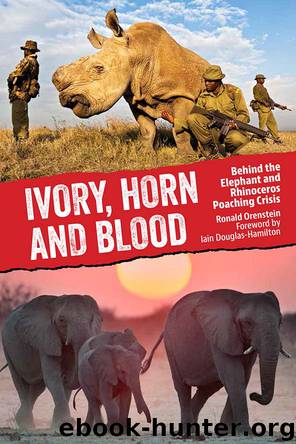Ivory, Horn and Blood by Ronald Orenstein

Author:Ronald Orenstein
Language: eng
Format: epub
Publisher: Firefly Books
Published: 2013-08-08T16:00:00+00:00
CHAPTER FOURTEEN
THE LAST RHINOS
For two rhinoceros subspecies, and possibly more, our best conservation efforts are already too late. The story of the Vietnamese Rhinoceros (Rhinoceros sondaicus annamiticus), a subspecies of the Javan Rhinoceros, is a sad — if not disgusting — tale of lost, found, and lost again. For many years, it was assumed that the only Javan Rhinos left in the world were the ones in Ujung Kulon in Indonesia. The populations that once roamed commonly throughout much of Southeast Asia were thought to be, irremediably, extinct. The vanished subspecies inermis of northeastern India, Bangladesh and Myanmar was last recorded in the early 1900s. Then, in 1988 — to everyone’s astonishment — a tiny population of annamiticus, perhaps 10 to 15 animals at most, was discovered in an area of southern Vietnam, a country so ravaged by war that it was thought that no creature as large as a rhinoceros could have survived. It later proved that some 39 more rhinos had been killed in Vietnam between 1957 and 1991. The last of them may have evaded notice for so long because they had shifted to a largely nocturnal way of life, perhaps in a futile effort to hide from poachers.
The area where they lived was proclaimed in 1992 as the Cat Loc Rhinoceros Reserve, incorporated in 1998 into nearby Cat Tien National Park. Despite the proclamation, human settlement flooded the reserve, converting much of the best rhinoceros habitat to rice paddies and cashew plantations. Motorbike tracks split the forest, and settlers left few places where the rhinos could reach vital water supplies in the dry season. Though Cat Loc covered an area of 135 square miles (35,000 ha), the rhinos were restricted to a mere 25 square miles (6,500 ha). By 2005, when a rhino conservation project was established as a successor to a seven-year effort funded by the government of the Netherlands, it was already too late. The project relocated almost 1,400 people living within the boundaries of the park and mobilized guards for regular, though poorly managed and largely unsupervised, rhino patrols, but political support for conserving the rhinos was largely absent. By that time there were probably only five or six animals left.
The remaining handful included males and females, but the last evidence of breeding was in January 1999. Camera traps told a tale of slowly dwindling numbers as the last continental Javan Rhinos died — or, most likely, were killed — one by one. A survey team from WWF and Cat Tien searched the area from October 2009 to April 2010, but the 22 dung samples they collected all proved to come from a single female. Shortly after the survey ended, in April 29, 2010, her dead and partially decomposed body was found in the park. She had been shot through the leg, probably in late January or early February, and her horn had been hacked off. On the mainland of Asia, the Javan Rhinoceros was extinct — this time for real. A WWF
Download
This site does not store any files on its server. We only index and link to content provided by other sites. Please contact the content providers to delete copyright contents if any and email us, we'll remove relevant links or contents immediately.
The Lonely City by Olivia Laing(4568)
Animal Frequency by Melissa Alvarez(4150)
All Creatures Great and Small by James Herriot(3986)
Walking by Henry David Thoreau(3681)
Exit West by Mohsin Hamid(3634)
Origin Story: A Big History of Everything by David Christian(3472)
COSMOS by Carl Sagan(3347)
How to Read Water: Clues and Patterns from Puddles to the Sea (Natural Navigation) by Tristan Gooley(3240)
Hedgerow by John Wright(3106)
How to Do Nothing by Jenny Odell(3102)
The Inner Life of Animals by Peter Wohlleben(3099)
How to Read Nature by Tristan Gooley(3078)
Project Animal Farm: An Accidental Journey into the Secret World of Farming and the Truth About Our Food by Sonia Faruqi(3018)
Origin Story by David Christian(2991)
Water by Ian Miller(2950)
A Forest Journey by John Perlin(2915)
The Plant Messiah by Carlos Magdalena(2745)
A Wilder Time by William E. Glassley(2690)
Forests: A Very Short Introduction by Jaboury Ghazoul(2671)
